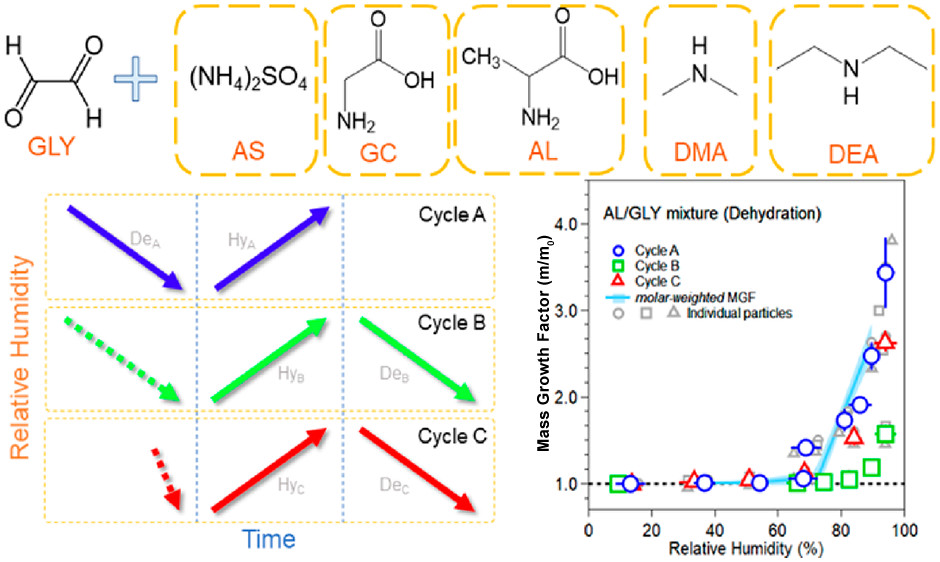Hygroscopicity and water uptake/evaporation kinetics of particles
Hygroscopicity, i.e., the ability of water uptake or evaporation, of aerosol particles determines the size distribution of a particle population when relative humidity (RH) varies. The size of particles, on the other hand, affects the capability of light scattering by the particles, thereby influencing the radiative budget of the atmosphere. With complex inorganic and organic components in atmospheric aerosol particles, the hygroscopicity is one of the properties that bring uncertainties in climate modelling. Furthermore, the dynamic changes of the aerosol composition due to reactions impose another challenge in our understanding of aerosol hygroscopicity.
The RH history that manifests the cycling of dehydration (water evaporation) and hydration (water uptake) may affect particle-phase reactions, products from which have strong influences on the physical properties and thus climatic effects of atmospheric particles. Using single-trapped particles, we show herein hygroscopic growths of mixed particles with reactive species undergoing three types of RH cycles, simulating different degrees of particle-phase reactions in the atmosphere. The reactive species are the widely known α-dicarbonyl glyoxal (GLY), and five reduced nitrogenous species, ammonium sulfate (AS), glycine (GC), l-alanine (AL), dimethylamine (DMA), and diethylamine (DEA). The results showed that the mixed particles after reactions generally had altered efflorescence relative humidity (ERH) and deliquescence relative humidity (DRH) values and reduced hygroscopic growths at moderately high RH (>80%) conditions. For example, with an additional slow drying step, the mean mass growth factors at 90% RH during dehydration dropped from 2.56 to 2.02 for GC/GLY mixed particles and from 2.45 to 1.23 for AL/GLY mixed particles. The reduced hygroscopicity with more RH cycling will thus lead to less efficient light scattering of the mixed particles, thereby resulting in less cooling and exacerbating direct heating due to light absorption by the products formed.

Chen X., Chu Y., Lee A.K.Y., Gen M., Kasthuriarachchi N., Chan C.K., Li Y.J.*, Relative humidity history affects hygroscopicity of mixed particles of glyoxal and reduced nitrogenous species, Environ. Sci. Technol., 2020, 12: 7097-7106.
Kasthuriarachchi N.Y., Rivellini L.H., Chen X., Li Y.J., Lee A.K.Y.*, Effect of relative humidity on secondary brown carbon formation in aqueous droplets, Environ. Sci. Technol., 2020, 54: 13207-13216.